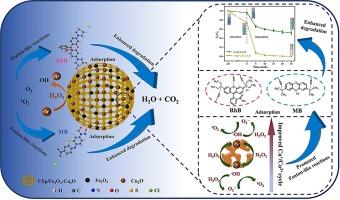天然孢粉素与Cu2O协同作用增强类fenton反应,深入了解其吸附对罗丹明b和亚甲基蓝的降解作用
IF 4.3
2区 工程技术
Q2 ENGINEERING, CHEMICAL
引用次数: 0
摘要
难降解有机染料在纺织、印刷、造纸、食品和制药行业的广泛使用是水污染的一个重要来源。本文首次以香蒲孢粉为骨架载体(CSp/Fe3O4-Cu2O)制备了一种新型的磁性空心多孔铜基fenton类催化剂,用于吸附和高效降解水中环境中的两种难降解有机染料罗丹明B和亚甲基蓝。在最佳条件下,CSp/Fe3O4-Cu2O表现出完全降解混合染料的能力。CSp/Fe3O4-Cu2O的降解动力学常数比对照Fe3O4-Cu2O提高了10.57倍。CSp/Fe3O4-Cu2O中香蒲孢粉(CSp)的中空多孔结构不仅吸附了染料,还通过吸附Cu2+促进Cu2+/Cu+的氧化还原循环,从而促进活性物质的持续生成,协同实现了混合染料的高效降解。此外,CSp/Fe3O4-Cu2O在3.0 ~ 11.0的广泛pH范围内对混合染料的降解率超过96 %,具有良好的应用前景;混合染料在各种水基质中完全降解,包括超纯水、自来水、松花江水;连续6次循环后,对混合染料的降解率可达98% %以上。综上所述,本研究开发的新型fenton类催化剂CSp/Fe3O4-Cu2O在化学工业中有机染料污染水的处理中具有很大的应用前景。该研究也为利用天然孢粉的优异吸附性能进行类芬顿催化降解有机污染物提供了新的思路。本文章由计算机程序翻译,如有差异,请以英文原文为准。


Natural sporopollenin cooperated with Cu2O for enhancing Fenton-like reaction and insight into its adsorption contributing to the degradation of rhodamine b and methylene blue
The extensive use of refractory organic dyes in the textile, printing, paper, food, and pharmaceutical industries is a significant source of water pollution. In this study, a novel magnetic hollow porous copper-based Fenton-like catalyst using cattail sporopollenin as a skeleton support (CSp/Fe3O4-Cu2O) was developed for the first time for the adsorption and efficient degradation of two refractory organic dyes rhodamine B and methylene blue in aqueous environments. Under the optimal conditions, CSp/Fe3O4-Cu2O showed complete ability to degrade the mixed dyes. The degradation kinetic constant of CSp/Fe3O4-Cu2O increased by 10.57 times compared to the control Fe3O4-Cu2O. The hollow porous structure of cattail sporopollenin (CSp) in CSp/Fe3O4-Cu2O not only adsorbed the dyes, but also promoted the continuous generation of active species by facilitating the redox cycling of Cu2+/Cu+ through the adsorption of Cu2+, which synergistically realized the efficient degradation of mixed dyes. Furthermore, CSp/Fe3O4-Cu2O showed promising application potentials as follows: degradation rates of over 96 % for mixed dyes in a wide pH range of 3.0–11.0; complete degradation of mixed dyes in various water matrices including ultrapure water, tap water, and Songhua River water; and degradation rates of over 98 % for mixed dyes after six consecutive cycles. Overall, the novel Fenton-like catalyst CSp/Fe3O4-Cu2O developed in this study was found to be highly promising for the treatment of organic dye-contaminated water in chemical industries. This study also provided new insight into using the excellent adsorption properties of natural sporopollenin for the Fenton-like catalytic degradation of organic pollutants.
求助全文
通过发布文献求助,成功后即可免费获取论文全文。
去求助
来源期刊

Chemical Engineering Science
工程技术-工程:化工
CiteScore
7.50
自引率
8.50%
发文量
1025
审稿时长
50 days
期刊介绍:
Chemical engineering enables the transformation of natural resources and energy into useful products for society. It draws on and applies natural sciences, mathematics and economics, and has developed fundamental engineering science that underpins the discipline.
Chemical Engineering Science (CES) has been publishing papers on the fundamentals of chemical engineering since 1951. CES is the platform where the most significant advances in the discipline have ever since been published. Chemical Engineering Science has accompanied and sustained chemical engineering through its development into the vibrant and broad scientific discipline it is today.
 求助内容:
求助内容: 应助结果提醒方式:
应助结果提醒方式:


